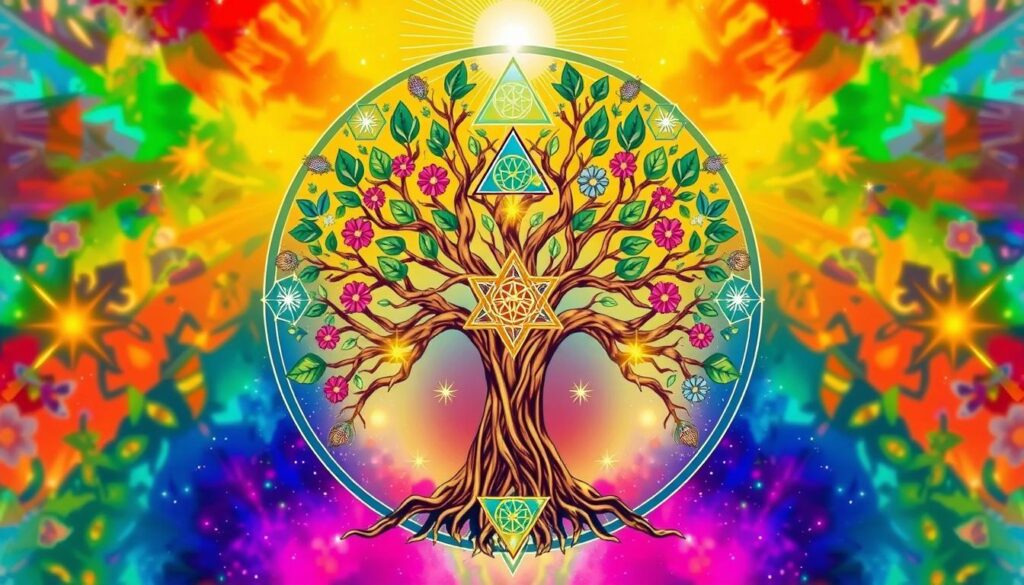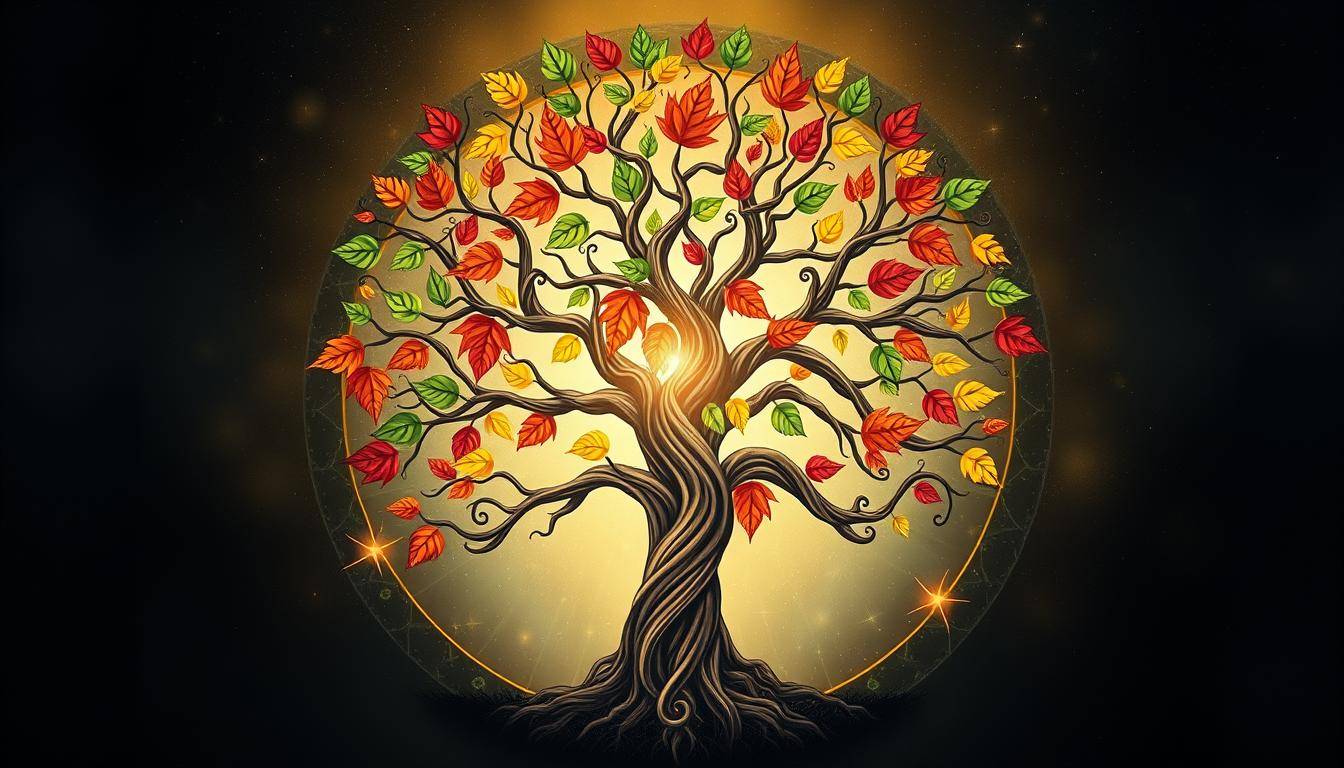“The tree of life is a symbol of our connection to the divine, a reminder that we are all part of a greater whole.” – Deepak Chopra
The Tree of Life is an ancient symbol with deep meanings across cultures and time. It stands for connection, unity, strength, growth, rebirth, family, and peace. It’s often seen as a big tree in a circle, showing balance and harmony.
This symbol has been important in many cultures, like Christianity, Ancient Egypt, Buddhism, African, Turkish, and Celtic traditions.
Key Takeaways
- The Tree of Life is a universal symbol found in many ancient cultures and traditions.
- It represents the interconnectedness of all life and the cycle of birth, growth, and renewal.
- The design of the Tree of Life often features a central tree with branches reaching up and roots reaching down, symbolizing the connection between heaven, earth, and the underworld.
- The Tree of Life is associated with themes of wisdom, knowledge, and the journey of spiritual enlightenment.
- Artistic and cultural representations of the Tree of Life continue to inspire and captivate people today.
Understanding the Ancient Symbol of Life and Wisdom
The Tree of Life is a symbol known across many cultures. It holds deep spiritual and philosophical meanings. It comes from ancient wisdom and has touched many hearts, showing life, growth, and the cosmos’ connection.
Origins and Historical Context
The Tree of Life’s roots go back to the start of human history. It’s found in many spiritual and religious traditions. From Kabbalah in Judaism to Hinduism’s sacred geometry, it shows our quest to understand life.
Universal Symbol Across Civilizations
The Tree of Life is a symbol that brings people together. It’s seen in many places, like the Celtic Crann Bethadh and the Nordic Yggdrasil. It stands for life’s cycle, balance between worlds, and the search for enlightenment.
Core Elements of the Design
The Tree of Life’s design is full of symbols with deep meanings. Its roots connect us to the earth and the underworld. The branches reach for the sky, showing our desire for spiritual growth.
The circle around the tree shows unity and the never-ending cycle of life. It’s a reminder of life, death, and rebirth.
| Symbol | Meaning |
|---|---|
| Roots | Connection to the physical world and the underworld |
| Branches | Aspiration for spiritual growth and divine understanding |
| Circular Enclosure | Unity and continuity of all existence, the eternal cycle of life, death, and rebirth |
The Tree of Life, with its sacred geometry and timeless symbols, still inspires people today. It reaches across time and cultures, touching hearts and minds.

“The Tree of Life is a universal symbol that has been used to represent the interconnectedness of all living things, the cycle of life, and the search for enlightenment.”
The Sacred Geometry of the Tree of Life
The Tree of Life shows the divine structure of the universe and the path to spiritual enlightenment. In Kabbalah, it has ten interconnected spheres (Sephiroth) and 22 paths. These paths map the soul’s journey from the material world to the divine.
Each Sephirah has a unique aspect of divine emanations. This framework helps us understand God, the cosmos, and the human soul.
The Tree of Life design is complex. It shows a deep connection between the Tree of Life and the Flower of Life. The Tree of Life has ten Sephiroth and 22 paths. This suggests a precise way to understand the universe and human experience.
The sacred geometry of the Tree of Life has inspired many artists and designers. It has been seen in painting, sculpture, and architecture. The Tree of Life’s cosmic unity inspires those who seek to show the divine in the physical world.
“The Tree of Life is a universal symbol that transcends cultures, religions, and time periods, connecting us to the sacred geometry that underpins the very fabric of existence.”

The Baobab tree is connected to the Tree of Life. Like the Tree of Life, the Baobab tree symbolizes cosmic unity. Its ancient, twisted trunk and vast, life-sustaining properties are like the Tree of Life.
The Tree of Life in Kabbalah and Jewish Mysticism
The tree of life is a key symbol in Kabbalah and Jewish mysticism. It shows the divine structure of the universe and the path to spiritual growth. At its core are the Sephiroth, ten interconnected spheres. These spheres represent different aspects of divine emanations.
The Ten Sephiroth
The ten Sephiroth, or divine manifestations, are:
- Keter (Crown)
- Hokhmah (Wisdom)
- Binah (Intelligence)
- Hesed (Mercy)
- Gevurah (Judgment)
- Tiferet (Beauty)
- Netzach (Endurance)
- Hod (Majesty)
- Yesod (Foundation)
- Malkuth (Kingdom)
These spheres, along with the 22 paths that connect them, form a blueprint. It helps us understand the divine emanations and the human soul’s spiritual journey.
Divine Emanations and Spiritual Paths
The Tree of Life in Kabbalah shows the process of spiritual growth. The 22 paths connecting the Sephiroth symbolize different stages of the journey. Each path is linked to a specific quality, archetype, or cosmic force. It guides the seeker towards a deeper understanding of the divine and the self.
Mystical Interpretations
The Tree of Life is a symbol with many meanings. It offers a framework for understanding God, the cosmos, and human experience. Through studying and contemplating this sacred diagram, Kabbalists and mystics seek spiritual harmony. They aim to unlock the mysteries of the universe.
“The Tree of Life is a map of the cosmos, a blueprint for the universe, and a guide to the soul’s journey towards spiritual enlightenment.”
Celtic Traditions and the Crann Bethadh
In Celtic culture, the Celtic Tree of Life, or Crann Bethadh, is very important. It shows the link between earth and sky, and between the living and their ancestors. This symbol is deep and lasting.
The Celts thought trees were their ancestors’ homes, leading to the Celtic Otherworld. The Crann Bethadh shows life’s cycle. Each tree type has its own meaning, showing Celtic values of balance and growth.
The oak tree was especially valued for its strength and long life. Some oaks lived over 300 years. The Celts saw oaks as symbols of nobility and strength, showing their ancestral roots. Some designs show the tree’s branches and roots, showing the connection between the divine, earth, and underworld.
“The Celts believed trees, particularly ancient oaks, were a source of life, with the Crann Bethadh at the center of their communities.”
The Crann Bethadh was more than spiritual. It was also a place for community gatherings. Scholars think ancient Irish communities held ceremonies here, showing its importance.
Today, the Celtic Tree of Life still inspires us. It reminds us of Celtic wisdom and love for nature.
Norse Mythology and Yggdrasil: The World Tree
In Norse mythology, Yggdrasil is a huge ash tree that connects the nine realms. Its roots go deep into the underworld, its trunk stands tall in the middle realm, and its branches reach the heavens. This tree symbolizes connection, strength, and the quest for knowledge in Viking culture.
Nine Realms of Existence
Yggdrasil’s roots and branches link the nine realms of Norse cosmology. Each realm is unique, with its own people and features. The tree acts as a bridge, allowing energy and messages to flow between these realms.
Mythological Creatures of Yggdrasil
Yggdrasil is home to many mythical creatures. An eagle sits at the top, while a squirrel named Ratatoskr carries messages between the eagle and the serpent Nidhogg. These beings show the cycle of life, death, and rebirth in Norse mythology.
Symbolism in Viking Culture
To the Vikings, Yggdrasil was more than a tree. It symbolized the connection of all things and the cosmic order. The tree’s strength in the face of Ragnarök showed Viking resilience and the value of wisdom.
“Yggdrasil, the legendary tree in Norse mythology, has roots that stretch into Niflheim, Jötunheim, and Asgard, symbolizing the interconnectedness of the nine realms.”
The Mystical Significance of the Tree of Life
The Tree of Life is filled with esoteric symbolism across many cultures. It shows how everything is connected and how spiritual growth happens in cycles. Its design and leaves show the balance between the physical and spiritual worlds. It reminds us of the eternal cycle of life, death, and rebirth.
The roots of the Tree of Life symbolize stability and connection to the earth. The trunk is about finding ourselves. The branches reach for our dreams and connect us to the divine. This structure helps us find balance and understand our dual nature.
In many religions and spiritual beliefs, the Tree of Life is seen as sacred. It offers insights into the universe and our souls. From the Kabbalah’s Ten Sephiroth to the Celtic Crann Bethadh and the Norse Yggdrasil, it has inspired many.
Thinking about the Tree of Life helps us see how everything is connected. It reminds us of our potential for spiritual growth and the power of life’s cycles.
| Tradition | Symbolic Significance |
|---|---|
| Kabbalah | The Ten Sephiroth, representing divine emanations and spiritual paths |
| Celtic | The Crann Bethadh, symbolizing balance, growth, and renewal |
| Norse | Yggdrasil, binding the nine realms of existence and embodying resilience and the pursuit of wisdom |
| Hindu | The banyan tree, representing divine wisdom, enlightenment, and the eternal cycle of birth, death, and rebirth |
The Tree of Life still fascinates us, inspiring spiritual growth and a deeper understanding of our connection to the cosmic unity. By embracing its symbolism, we can discover the deep mysteries of our existence.
“The Tree of Life is a symbol of the interconnectedness of all things, a reminder that we are part of a greater whole, and that our individual growth and transformation are inextricably linked to the collective journey of humanity and the cosmos.”
Eastern Interpretations: Buddhist and Hindu Perspectives
The Tree of Life is very important in Eastern spiritual traditions. It is seen in the Bodhi Tree of Buddhism and the Peepal and Banyan trees of Hinduism. These symbols talk about enlightenment, being connected, and the cycle of life.
The Bodhi Tree and Enlightenment
The Bodhi Tree is special in Buddhism. It’s where the Buddha found enlightenment. This tree, also known as the Sacred Fig, stands for spiritual awakening and freedom from suffering.
It shows the path to finding oneself and understanding the world and self. It’s about seeing beyond the material world to find true self and the universe.
Hindu Symbolism and Sacred Trees
In Hinduism, the Tree of Life is seen in the Banyan and Peepal trees. The Banyan tree shows how everything is connected. It represents the unity of heaven and earth.
The Peepal tree is linked to Lord Vishnu and Lord Krishna. It stands for eternal life and the cycle of birth, death, and rebirth. It also shows how we can connect with the universe.
In both Buddhism and Hinduism, sacred trees are symbols of wisdom, life, and connection. They remind us of the unity in diversity. They encourage us to understand our role in the universe.
Symbolism of Roots, Trunk, and Branches
The Tree of Life is a deep symbol that goes beyond cultures, religions, and time. Its parts – roots, trunk, and branches – each have special meanings. Together, they show how everything in the world is connected.
The roots of the Tree of Life stand for stability, connection to the past, and grounding. They keep you tied to the earth and the wisdom of your ancestors. The trunk is about strength, growth, and living in the moment. It shows the resilience needed for your spiritual growth.
The branches reaching up symbolize your dreams, connections, and reaching for the divine. This structure shows the balance between living on earth and growing spiritually. It reminds us to respect our roots, grow, and reach for the divine.
“The tree of life is a universal symbol found in many religious and spiritual traditions, representing the interconnectedness of all things and the cycle of life, death, and rebirth.”
Understanding the Tree of Life’s parts can help you grow spiritually and connect with nature. Embrace your roots for grounding, your trunk for strength, and your branches for dreams. This journey will lead you to wholeness and harmony.
Connection Between Heaven, Earth, and the Underworld
The Tree of Life connects heaven, earth, and the underworld. It’s a key idea in many mythologies, like Norse (Yggdrasil) and Kabbalah. The tree shows the universe’s structure, with roots in the underworld, a trunk on earth, and branches in the heavens.
Cosmic Axis and Divine Order
The Tree of Life is a symbol of connection between different worlds. It shows how everything in the universe is linked. Its design reflects the divine order, blending the spiritual and physical, and the celestial and earthly.
Spiritual Pathways and Connections
The Tree of Life is like a map for the soul’s journey. It guides us through spiritual pathways to growth and enlightenment. Its branches represent the many ways we can connect with the cosmic axis and the divine order.
“The Tree of Life is a symbol of the interconnectedness of all things, a cosmic axis that bridges the divide between the heavens, the earth, and the underworld.”
Understanding the Tree of Life helps us see the universe’s mysteries and our spiritual growth. It encourages us to explore the spiritual pathways that link us to the divine, nature, and the unknown.
The Tree of Life in Modern Spirituality
In modern spirituality, the Tree of Life is very important. It guides us towards personal growth, healing, and understanding our connection to everything. This symbol is used in many spiritual practices, like meditation and yoga.
The Tree of Life shows how our body’s energy centers are connected. It helps us see how our spiritual and physical health are linked. This makes it easier to find balance and harmony.
Many people find the Tree of Life inspiring for their personal growth. It talks about life, death, and rebirth, which helps us find balance and connect with nature. It encourages us to think deeply about ourselves and the world.
“The Tree of Life, with its intricate branches and roots, serves as a powerful reminder of the interconnectedness of all things. It invites us to embrace the cycles of growth, transformation, and renewal that are inherent to the human experience.”
The Tree of Life is a big inspiration in modern spirituality. It helps us grow, heal, and understand our place in the world. Its powerful symbolism continues to inspire those looking for a more fulfilling life.
Artistic Representations Through History
The Tree of Life has been a key symbol in art for ages. It has crossed over many cultures and time periods. Artists and viewers have always been drawn to it.
Religious Art and Iconography
In religious art, the Tree of Life is seen in many forms. This includes illuminated manuscripts, church decorations, and Islamic geometric patterns. Ancient places like Mesopotamia and Egypt used it in their temple art and royal items.
This symbol shows its spiritual importance. It has been a part of many faiths’ art traditions.
Contemporary Interpretations
Today, the Tree of Life still inspires artists. They explore its meanings of ecology, spirituality, and human connection. Works like Gustav Klimt’s “The Tree of Life, Stoclet Frieze” and the Mozambican sculpture “Tree of Life” for peace show its lasting appeal.
Artists use different mediums to give the Tree of Life new meanings. These interpretations speak to people all over the world.
The Tree of Life’s lasting impact in art shows its deep symbolic value. It has moved from ancient religious art to modern interpretations. This symbol continues to inspire and help us understand our connection to the world and each other.
Conclusion
The Tree of Life is a powerful symbol across cultures and time. It represents growth, connection, and renewal. It shows the balance between the earthly and spiritual worlds.
From ancient myths to today’s spiritual practices, the Tree of Life inspires us. It helps us see how everything is connected. It teaches us about the cycle of life.
The Tree of Life has fascinated people for centuries. It appears in many religions and myths around the world. It’s seen as a majestic tree or a cosmic axis linking heaven, earth, and the underworld.
This symbol shows the web of life, growth, and wisdom. It guides us on our journey to spiritual awakening and enlightenment.
The Tree of Life’s legacy shows our eternal quest for understanding. As you face life’s challenges, let this symbol guide and inspire you. It reminds us of our connection to all living beings and the growth we can achieve.
FAQ
What is the significance of the Tree of Life symbol?
The Tree of Life is an ancient symbol. It stands for connection, unity, and strength. It also represents growth, rebirth, family, and tranquility.
It’s found in many cultures worldwide. It shows the divine structure of the universe and the path to spiritual enlightenment.
How is the Tree of Life represented in different cultures?
The Tree of Life is seen in myths, philosophies, and religions across cultures. This includes Christianity, Ancient Egypt, Buddhism, African, Turkish, and Celtic traditions.
The design often shows a flourishing tree with strong roots inside a circle. This circle represents the connection between the physical and spiritual worlds.
What is the significance of the Tree of Life in Kabbalah?
In Kabbalah, the Tree of Life is key. It represents the divine structure of the universe and spiritual enlightenment. It has ten Sephiroth, or spheres, that embody different divine aspects.
There are also 22 paths connecting these spheres. These paths represent spiritual journeys and the quest for wisdom.
How is the Tree of Life represented in Celtic and Norse traditions?
In Celtic culture, the Tree of Life (Crann Bethadh) connects the earth and heaven. It also links the living and ancestors.
In Norse mythology, Yggdrasil is the cosmic axis. It binds together the nine realms of existence. It shows the cycle of life, death, and rebirth.
What are the symbolic meanings of the different components of the Tree of Life?
The roots of the Tree of Life symbolize grounding and stability. They connect us to ancestral wisdom.
The trunk represents strength, growth, and the present moment. The branches reaching towards the sky symbolize aspirations and spiritual growth.
They also connect us to higher realms. This balance is between earthly existence and spiritual ascension.
How is the Tree of Life represented in Eastern spiritual traditions?
In Buddhism, the Bodhi tree is sacred. It’s where Buddha attained enlightenment, symbolizing spiritual awakening and liberation from suffering.
In Hinduism, the Tree of Life is often the banyan or Peepal tree. It’s associated with Lord Vishnu and Lord Krishna. It symbolizes eternal life, the cycle of birth, death, and rebirth, and the unity of all existence within the cosmic order.
How is the Tree of Life depicted in art throughout history?
The Tree of Life has been a key motif in art. It appears in religious art, illuminated manuscripts, church decorations, Islamic geometric patterns, and ancient artifacts.
In modern and contemporary art, it continues to inspire artists. It explores themes of ecology, spirituality, and human connection.




























































